 |
Nikon D2X Autofocus SystemText and photography copyright Ed Erkes. All rights reserved.
The Nikon D2X contains Nikon’s most advanced and complicated autofocus system. The D2X offers an unprecedented number of focusing system options that can be accessed through a series of buttons, levers, and custom menu settings (CSM a1-a5). The options include:
- Two AF activation methods: Shutter/AF-On button or AF-On button only
- Three Focus Modes (two of which are AF):
- S (AF-S)- Single-servo
- C (AF-C)- Continuous-servo
- M- Manual
AF-S and AF-C can be set to either Focus priority or Release priority via CSM a1 and a2.
- Four AF Area Modes: The AF Area Modes determine which focusing sensor(s) are active during initial focus acquisition and predictive focus tracking. The active sensor(s) may either be user-selected or camera-selected (Closest Subject).
- Single Area AF
- Dynamic Area AF
- Group Dynamic AF
- Dynamic Area AF with Closest Subject Priority
- Enabling/Disabling Lock-On for Predictive Focus Tracking: Set via CSM a4, this option determines how autofocus action reacts to sudden large changes in the focus distance in front of the active sensor.
The choices selected combine to determine how the camera’s autofocus system functions. The various combinations of choices can create a confusing number of AF possibilities. Unfortunately, Nikon’s instruction manual is not particularly well written and, in my opinion, makes things even more confusing. I also found Thom Hogan’s D2X eBook confusing in its description of focus modes, although it does explain very well some aspects of the AF system that are not discussed in the instruction manual. The best source, by far, is Darrell Young’s article, Understanding Multi-CAM 2000 Autofocus published on the Nikonians website. His article is a Must Read for anyone wanting to better understand the Nikon D2X AF capabilities.
This article is my attempt to organize the different AF options in an understandable manner (for me). It initially began as a simple outline with notes, but, in the spirit of sharing with others, has been expanded. By carefully considering the various options, how they interact, and one’s own shooting style, one can eliminate many of the combinations and narrow down the options for specific shooting situations. I’ll discuss the various options as well as the rationale for my own preferences. To better understand my personal choices, it would probably be useful to discuss the type of photography that I do. I’ve been a serious amateur photographer since 1982. I do not photograph sports, nor do I do wedding/event photography. I specialize in scenic and nature photography. For the last seven years, photographing birds with telephoto lenses has been my favorite photographic activity. However, I have only been using an autofocus telephoto lens (the Nikon 200-400 f4.0 VR) for a little over a year. Some of my images can be seen at members.photoportfolios.net/ederkes.
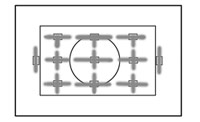 The D2X has eleven AF sensors. Nine of the sensors are sensitive to both horizontal and vertical detail. The three sensors in the center row are crosshatched. The upper and lower rows consist of sensors that are T- shaped and inverted T-shaped, respectively. The far right and left sensors are narrow lines that are sensitive to detail in the cross-axis direction only. It is important to note that the actual sensor shape does not correspond to that depicted by the viewfinder focus brackets. The sensors are narrower and longer than the viewfinder focus brackets. For reliable accurate AF, it is best if the subject covers approximately half the sensor area. Gray bars indicate approximate shape of actual sensors. The D2X has eleven AF sensors. Nine of the sensors are sensitive to both horizontal and vertical detail. The three sensors in the center row are crosshatched. The upper and lower rows consist of sensors that are T- shaped and inverted T-shaped, respectively. The far right and left sensors are narrow lines that are sensitive to detail in the cross-axis direction only. It is important to note that the actual sensor shape does not correspond to that depicted by the viewfinder focus brackets. The sensors are narrower and longer than the viewfinder focus brackets. For reliable accurate AF, it is best if the subject covers approximately half the sensor area. Gray bars indicate approximate shape of actual sensors.
I. Two AF Activation Methods: controlled via CSM a5
- Shutter Button/AF-On Button: (Default setting) AF is initiated by either pressing the shutter button halfway or by pressing the AF-On button.
- AF-On Only: Selecting this option separates the focusing action from the shutter release. AF can only be initiated by pressing the AF-On button. Pressing the shutter button has no effect on autofocus action. However, the focus status can have a definite effect on shutter release. If camera Focus Mode (AF-S or AF-C) is in Focus priority, then the shutter will only release if the area in front of active AF sensor is in focus.
*I have set CSM a5 to AF-On Only, to separate AF action from the shutter release button. I use the AF-On button almost exclusively for auto focusing.
II. Three Focus Modes
- S (AF-S): Single-servo AF (Camera focuses, then locks focus)
- C (AF-C): Continuous-servo AF (Camera continually adjusts focus, does not lock)
- M- Manual focus (will not be discussed)
Focus Modes are selected via a lever on the front of camera, next to the lens mount.
The two AF focus modes can be modified through custom functions CSM a1 and a2—allowing two types of shutter-release priorities to be set: Focus priority or Release priority.
- AF-S- Single Servo: With a stationary subject, the camera autofocuses and locks focus on the subject. If the subject then moves before photo is taken, it will be out of focus unless you release the focus button and then re-press to reacquire focus. If the subject was moving when the focus button was initially pressed, then camera will predictively track focus until subject stops. Once subject stops moving, focus locks as noted as above.
CSM a2 options
AF-S with Focus Priority: (Default setting) The camera shutter will not fire unless subject in front of active AF sensor is in focus.
AF-S with Release Priority: Camera shutter can be fired even if subject in front of active sensor is out of focus.
Nikon recommends AF-S for use with relatively static subjects. AF-S is often used with the “Focus, then Compose” technique--generally with the D2X in AF-S and its default CSM a2 and a5 settings (AF-S in Focus priority setting and shutter button activating AF). The selected AF sensor is positioned over the subject and focus is locked by pressing halfway on shutter release. The camera is then shifted to place the subject in the desired composition within frame and photo is taken. In Single Frame (S) Advance mode, only one photo with this composition can be taken at a time, since the shutter button must be released before a second photo can be taken. Unfortunately, releasing the shutter button unlocks focus and, when then pressed again, the camera will refocus on the area now in front of active sensor (and original subject will then be out of focus).
There are several methods available to work around this problem and allow the taking of multiple photos without having to repeat the “Focus, then Compose” technique for each shot.
- One can press the AF-On button to lock focus (essentially it acts the same as keeping the shutter button partially depressed). With the AF-On button depressed, the focus remains locked as you release pressure off the shutter button.
- The AE-L/AF-L button can be depressed to lock focus and allow multiple photos to be taken without having to repeat “Focus, then Compose.” Note: There is no AE-L/AF-L button near the vertical shutter release, however the vertical AF-On button can be programmed via CSM a8 to function as an AE-L/AE-L button.
- Switch from Single Frame Advance to a Continuous Frame Advance mode (CL or CH). You will not have to release the shutter button to take a second shot. You can easily take multiple photos as long as shutter button is kept partially depressed.
*I seldom use AF-S mode any longer, except in dim lighting and/or low contrast conditions—situations where the capabilities of any AF system are challenged. If the AF action slow downs with more hunting and searching, I want the camera to lock focus once achieved. Obviously this works only with relatively stationary subjects.
- AF-C- Continuous Servo: The autofocus never locks on subject. As long as the focus button is pressed, the camera continually tracks a moving subject and constantly adjusts focus. AF-C can be set to Focus or Release Priority through CSM a1 settings.
CSM a1 options
AF-C with Focus Priority: The camera continually focuses but the shutter will only release when the subject in front of the active sensor is in focus. Since the camera will not fire until in-focus confirmation is received, there is the possibility of a shutter delay between pressing the shutter button and the shutter release. With fast action, this delay may not be desirable.
AF-C with Release Priority (actually termed FPS Rate): (Default setting) Photos can be taken whenever the shutter release button is pressed, even if the subject is out of focus. The rationale is that continuing focus action may achieve focus during the time period that the mirror lifts and shutter opens. Another possibility is that there may be adequate depth of field to cover desired area of focus.
CSM a1 also offers a third option termed FPS Rate + AF which is basically Release Priority with some emphasis on focus. When in CL or CH advance modes, the frame advance rate may slow, if needed, to allow for improved focus accuracy if subject is dark or low in contrast.
*I use AF-C almost exclusively, presently using FPS Rate (Release priority)
Rationale for my preferences from Part I. and II.-- AF-C (Release Priority) with AF-On button for activating autofocus:
When I first started using the D2X, I primarily used AF-S Focus mode in CL or CH frame advance. I used the shutter button for activating AF and usually used the “Focus, then Compose” technique. By using a continuous frame advance mode (CL or CH), I could easily take multiple photos after composing as long as I kept the shutter button partially depressed.
When I was photographing action—for example, birds in flight—I would switch to AF-C Focus mode in CL or CH. I would continue to use the shutter button to initiate autofocus.
These AF methods worked well most of the time. However, there were times when I missed potentially exceptional images because I was in AF-S mode and could not switch to AF-C quickly enough when interesting action occurred, for example, an egret or heron that would suddenly take flight.
I soon realized that in order to be continually ready for action photography, I needed to keep the camera in AF-C mode. However I also wanted to be able to use the “Focus, then Compose” technique. My solution was to use the AF-On button for autofocusing (setting CSM a5 to AF-On Only), and AF-C mode in Release priority (setting CSM a1 to FPS Rate). The “Focus, then Compose” technique could easily be performed by placing the active AF sensor on subject and then pressing AF-ON button to acquire focus. The AF-On button was then released, the camera shifted for proper composition, and the photo taken. **See box below for an alternative method to use “Focus, then Compose” in AF-C focus mode.
The advantages of AF-On with AF-C in Release priority:
- You’re always ready for action photography
- The “Focus, then Compose” technique can still be easily used
- Switching to manual focus with telephoto lenses is easily accomplished at any time by simply releasing AF-On button and manually turning focusing ring
Note: To use the “Focus, then Compose” process with AF-On Only and AF-C focus mode, Release Priority (FPS Rate) must be used. If the AF-C focus mode is set to Focus Priority, then the shutter will not fire once camera is shifted for desired composition (since the area now in front of active AF sensor would be out of focus).
Admittedly, it does take some time to get adjusted to using the AF-On button. Initially there will be some fumbling at times to locate the AF-On button with your thumb. This problem is compounded by the fact that the vertical release AF-On button is in a different (more vertical) position compared to the horizontal release AF-ON button. With practice, however, it will soon become second nature.
|
**Alternative Solution: One can also use the “Focus, then Compose” process in AF-C mode with Shutter Button activating AF (CSM a5 in default setting). Simply press the AE-L/AF-L button to lock AF and then recompose. To do the same when using the vertical shutter release, you must use CSM a8 to reprogram the vertical AF-On button to function as an AE-L/AF-L button. This method works, but I prefer to completely separate AF from shutter release by setting CSM a5 to AF-On only.
|
Some photographers question the accuracy of AF-C for routine photography since they find that the camera often continually adjusts focus on a “stationary” subject. They consider this a sign that the camera is “hunting” for the correct focus. In actuality the camera is simply doing what it is supposed to be doing—continually adjusting focus after subject or camera movement. Often it is the camera that is moving—slightly shifting the active sensor position horizontally and/or vertically across a three-dimensional subject. You can check this out easily for yourself by focusing on a two-dimensional, high contrast subject (such as a brick wall) with camera locked in position on a tripod. The camera will focus quickly and accurately, without hunting, whether in AF-S or AF-C mode.
Note: In low light with low contrast subjects, the D2X can be slow in acquiring focus. The focus indicator oscillations that are occurring in this situation may actually be due to “hunting” for correct focus rather than adjusting to subject/camera movement. The result will be out of focus images. In these situations, it may be best to use AF-S, which locks focus once acquired, or to manually focus.
Other photographers complain of a problem using the AF-On button for AF acquisition when using telephoto lenses with VR. Since the AF-On button does not activate vibration reduction, they feel that VR “kicking in” as the shutter button is depressed can blur images. I have not noticed this problem, but I tend to partially depress the shutter button as I get ready to take a photo, allowing VR to activate before fully depressing the shutter button.
III. AF Area Modes
There are four AF Area Modes. The AF Area Mode determines which sensor(s) are active in initial focus acquisition and predictive focus tracking. The active sensor(s) can either be user-selected or camera-selected (Closest Subject).
- Single Area AF: Only one of the AF sensors is used for AF. The sensor is user-selected. To allow predictive focus tracking to operate with moving subjects, the AF sensor must be kept positioned over the subject. If the sensor drops off the subject, the camera AF mechanism will start focusing on the area now positioned in front of the AF sensor. The camera may try to focus on areas in the foreground or background and in low contrast situations may hunt and search. The Nikon instruction manual recommends Single Area AF for relatively static subjects or with moving subjects that can be easily kept within active focus sensor.
- Dynamic Area AF: Focusing begins with the user-selected AF sensor but the camera will switch focus to other sensors to follow a moving subject. If the subjects moves onto an adjacent sensor, predictive focus will track its movement and AF activity will be transferred to sensor positioned over the subject. Nikon recommends Dynamic Area AF for erratically or rapid moving subjects—situations where it may be difficult to keep a single active sensor positioned on the subject.
- Group Dynamic AF: Group Dynamic AF is the most complex of the AF Area Modes. Instead of selecting a single initial focusing sensor, the user selects a group of sensors. CSM a3 determines the number/shape of sensors in the group (the pattern) and how initial focus acquisition is achieved (center sensor or closest subject). Nikon recommends Group Dynamic AF for erratically or rapid moving subjects—in situations when one knows the general area within frame where action will occur.
CSM a3 Options are Pattern 1/Center Sensor, Pattern 1/Closest Subject, Pattern 2/Center Sensor, and Pattern 2/Closest Subject
- Pattern: Either a diamond/triangular pattern of four/five sensors (Pattern 1) or a row/triangular pattern of three/four sensors (Pattern 2) can be selected (see figure below).
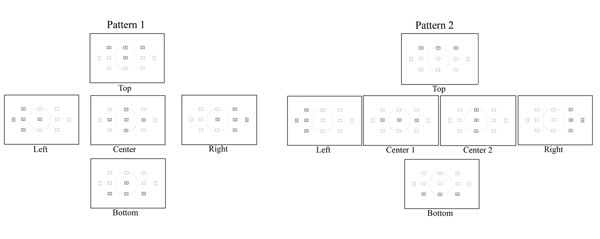
- Initial Focus Acquisition: Center Sensor or Closest Subject.
With Center Sensor selected by CSM a3, initial focus acquisition will be performed with the center sensor of the user-selected group but can switch to other sensors in the group if the subject moves. Using center sensor does limit initial focus acquisition to only five of the eleven AF sensors (the center sensor of each group). Dynamic Area AF, on the other hand, allows any one of the eleven sensors to be selected for initial focus acquisition.
In Closest Subject Priority, the camera will analyze contrast and distance information in front of each sensor of the selected group and will attempt to focus on the closest subject. When one presses the focus button the selected group of sensors will light up in red briefly. In AF-S mode, the sensor that acquires focus will blink in red briefly once AF is achieved. In AF-C mode, the sensor used to set focus will blink in red briefly after photo is taken.
- Dynamic Area AF with Closest Subject Priority: All eleven AF sensors are active and the camera always attempts to focus on the closest subject. There is no user input at all on the sensor selected. The camera analyzes contrast and distance information in front of all AF sensors and will try to focus on the closest subject. In AF-S mode, the sensor that acquires focus will light up in red briefly once focus is achieved. In AF-C mode, the focus sensor that set the focus will light up briefly immediately after the photo is taken. According to the Nikon D2X manual (p.77), “Camera may be unable to select focus area containing closest subject when telephoto lens is used or subject is poorly lit. Single Area AF is recommended in these cases”. Nikon recommends this mode for erratically or rapid moving subjects when you know that subject will be closest object to camera.
In my tests, Dynamic Area AF with Closest Subject sometimes focused on a more distant object if it was higher in contrast. This was true whether the lens was wide angle or telephoto and it was especially true in low light situations. Group Dynamic AF (in Closest Subject Priority) would usually focus on a near lower-contrast object more reliably than Dynamic Area AF with Closest Subject. It is logical that Group Dynamic AF with Closest Subject priority would focus faster and more accurately than Dynamic Area AF with Closest Subject priority. Fewer sensors are active in Group Dynamic AF so less distance/contrast data has to be analyzed. Theoretically, using the same logic, Pattern 2 should be more responsive than Pattern 1, since fewer sensors are active.
Also in my tests, initial AF acquisition was generally faster with a user-selected AF sensor than when the camera was in Closest Subject priority. With a user-selected sensor, the camera knows which sensor to use for initial focusing; it does not have to analyze data from multiple sensors (as in Closest Subject modes) before beginning initial focusing action.
Deciding which AF Area Mode works best for particular situations requires testing under different conditions. I honestly haven’t worked with the different modes enough to make definitive conclusions, but I’ll share my opinions.
When speed of initial focus acquisition is the prime consideration, the camera’s AF responsiveness will be faster with a user-selected sensor than a camera-selected Closest Subject sensor. So the reason to use the Closest Subject modes would be for situations with erratic action in which the camera would probably pick up the closest subject quicker than the photographer can find and center the subject on a selected sensor. Of the Closest Subject modes, Dynamic Area AF with Closest Subject would be the slowest since the camera has to analyze data from all eleven sensors before initiating AF. Group Dynamic AF with Closest Subject should be faster since fewer sensors are active, and as mentioned above, Pattern 2 should theoretically be faster than Pattern 1.
The logic gets more complicated with the user-selected modes. Is Single Area AF mode faster than Dynamic Area AF? If it isn’t, why would we need a Single Area AF mode? Using the same logic, one would assume that Group Dynamic AF with Center Sensor selection is faster than Dynamic Area AF, since fewer total sensors are involved in the AF algorithms, and that Pattern 2 would be more responsive than Pattern 1. At the present I’m not sure how much of this discussion actually involves practical vs. just theoretical differences.
*Presently I’m using Dynamic Area AF most of the time. With subjects moving directly toward me, I sometimes use Group Dynamic Area AF (with center sensor selection). I have been experimenting with Group Dynamic AF (with Closest Subject Priority) and Dynamic AF with Closest Subject Priority on flight shots with birds.
IV. Predictive Focus Tracking with Lock-On: Set via CSM a4
Prevents sudden large changes in focus distance from causing the camera to restart focus acquisition. It is designed to prevent errors in focus due to either the photographer failing to keep sensor on subject or another object briefly passing between subject and sensor. Lock-on is enabled by default. Previous Nikon cameras, such as the F5 and D1X, had “Lock-on” built into the AF algorithms. The D2x has added the capability to turn it off, if desired.
*I usually leave Lock-On enabled in my photography. When I’m photographing flying birds, I try to keep the active sensor on the head and/or neck of the bird. However, this is not always easy to do with a fast-moving subject. Lock-On prevents abrupt loss of focus due to the sensor dropping off the bird and onto the background. It also prevents loss of focus due to a foreground object passing in front of subject. With flight shots, the foreground object that passes in front of the sensor can sometimes be the near wing of the bird as it flaps up and down. If I disable Lock-On, I find that I more easily lose focus on flying birds, especially if I’m using teleconverters on my telephoto lens (especially with a 2X converter, where initial focus acquisition is much slower).
Examples
Note - Thumbnails are links to larger images.
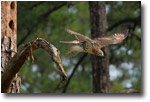
Photo 1 |
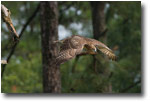
Photo 2 |
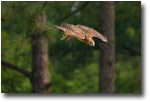
Photo 3 |
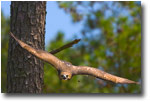
Photo 4 |
Photos 1 - 3; Nikon D2X. 200-400AF f4.0 VR lens with TC20EII teleconverter. Dynamic Area AF with center sensor selected. I spent the better part of three days photographing a pair of juvenile red-tailed hawks that allowed a closer approach than any other hawks I’ve tried to photograph. I later learned that they had been born and raised in captivity and just recently released to the wild. I had been photographing this hawk perched on a branch when he suddenly swooped down to catch a small mammal. Because I was using AF-C mode and had been prefocused on the perched bird, all three flight images were sharp—even though I was using a 2X teleconverter.
Photo 4 - Nikon D2X. 200-400 f4.0 VR lens with TC14EII. Group Dynamic AF Pattern 1/Center Sensor (Center group selected). The wildlife rehabilitator was still providing supplemental feedings to the released hawks. He let me photograph during one feeding. The bird dropped more than anticipated when he left the branch, but predictive focus tracking continued to function as the bird moved from the center sensor onto the lower sensor. He was halfway off the bottom of frame by the next shot and I totally lost him on the following one. By cropping to more of a panoramic format, I was still able to make a print with a nice composition.
Photos 5 - 7; Nikon D2X. 200-400 VR lens with TC20EII. Dynamic Area AF with center sensor selected. Top two images were cropped for more pleasing composition. With no foreground objects closer than the tundra swans, one of the focus modes with Closest Subject priority could have been used. In the lower photo, there is the risk that, as the swan dropped further, a Closest Subject mode may have transferred focus to foreground grasses (especially if a Pattern 1 group was selected). I didn’t use a Closest Subject mode in any of these because AF acquisition is slow with a 2X converter on the 200-400 and I get better results with Dynamic Area AF and a user selected sensor.
Comments on NPN nature photography instructional articles? Send them to the editor.


|



